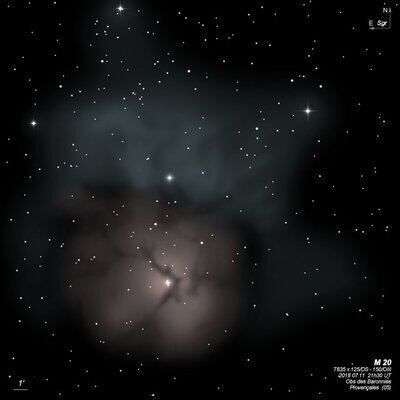Trifid Nebula
Trifid Nebula

15x50 IS binoculars: visible as a small, faint glow surrounding a the central "star".
Charles Messier discovered M20 = NGC 6514 = H IV-41 = H V-10/11/12 = h1991 = h3718 on 5 June 1764 and noted a cluster of stars. William Herschel first observed M20 on 12 Jul 1784 (sweep 236) and recorded, "Three nebulae, but they seem to join faintly together, forming a kind of triangle; in the middle of which is less nebulous, or perhaps free from nebulosity is a double star of the 2nd or 3rd class. As I intended to revisit this place very soon I passed on, but think more very faint nebulosities are following." He assigned it three catalogue numbers, V 10, V 11 and V 12. His reference star was misidentified, though (4 Sgr = SAO 186061 instead of 5 Sgr = SAO 186074), so his position is incorrect. William Herschel also reobserved the Trifid on 26 May 1786 (sweep 566) and recorded IV-41 using a different reference star as "a double star with extensive nebulosity, of different intensity; about the double star is a black opening, resembling the nebula in Orion, on a small scale." John Herschel combined these numbers into a single GC entry (4355). Harold Corwin notes he made the same error with NGC 6533.
John Herschel first used the name "Trifid" to describe M20 in the Slough Catalogue (1 Jul 1826): "vL; trifid, three nebulae with a vacuity in the midst, in which is centrally situated the double star Sh 379, neb = 7' in extent. A most remarkable object." Interestingly neither William or John referred to this object as M20, possibly because of positional confusion or because Messier called it a "star cluster". The equivalence was given in the GC 4355.
In John Herschel's Cape Observations (1847) and "Outlines of Astronomy" (1849) he described "One of the them [several nebulae in Sagittarius] is singularly trifid, consisting of three bright and irregularly formed nebulous masses, graduating away insensibly externally, but coming up to a great intensity of light at their interior edges, where they enclose and surround a sort of three-forked rift, or vacant area, abruptly and uncouthly crooked, and quite void of nebulous light. A bright triple star is situated precisely on the edge of one of these nebulous masses just where the interior vacancy forks out two channels. A fourth nebulous mass spreads like a fan or downy plume from a star at a little distance from the triple nebula."
200/250mm - 8" (7/16/82): the famous rift structure is fairly prominent with a triple star at the center. The NW rift is more subdued. An easily visible reflection nebula is close north.
300/350mm - 13.1" (7/16/82): bright, fairly large, contains three inky black dark lanes (B85) with sharp edges. Structure is visible along the dark lanes and in the center. The prominent central star is a quadruple (4th star difficult) consisting of a mag 7.6/10.4 pair at 6" and a mag 8.7/10.5 pair at 2.3", the brighter stars separated by 11". The NW lane is wider and fainter than the other two lanes. A round, bluish reflection nebula is separated, but very close north. The view improves using a UHC filter.
400/500mm - 18" (8/12/10): the emission component of M20 was sketched and observed carefully at 175x. At the intersection of the dark lanes is the multiple central star HN 40 with a mag 7.6/10.4 pair at 6" and a tight mag 8.7/10.5 pair at 2.3", with the two pairs are separated by 11". Four lanes (B85) emanate from the bright central hub. A narrow lane starts NW of the multiple star and heads 2.5' due N, where it stops at a mag 10 star. Near the base of this lane another branch heads west to the edge of the nebula. Another lane heads SSE for ~2.5', tapering at the end. A prominent lane shoots 3.5' NE and has a few short branches, including one just NE of the central stars. This lane is bordered by a couple of mag 10.5-11 stars on its south edge. There is an extension at the NE end that bends to the north and exits the main nebulosity and merging with a dusty region just SE the reflection component to the north. A mag 9.4 star is at the north edge of the main emission component. The blue reflection component surrounds mag 7.3 HD 164514 and extends ~6' with an irregular structure.
Notes by Steve Gottlieb